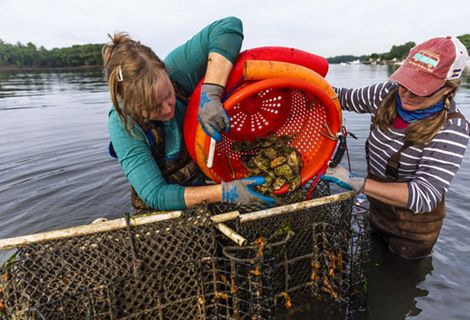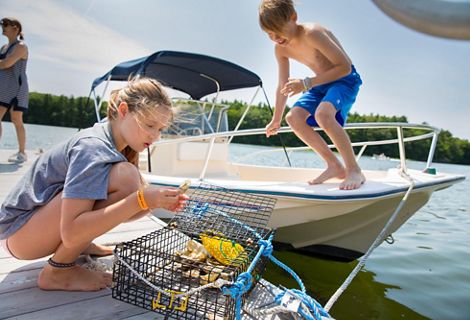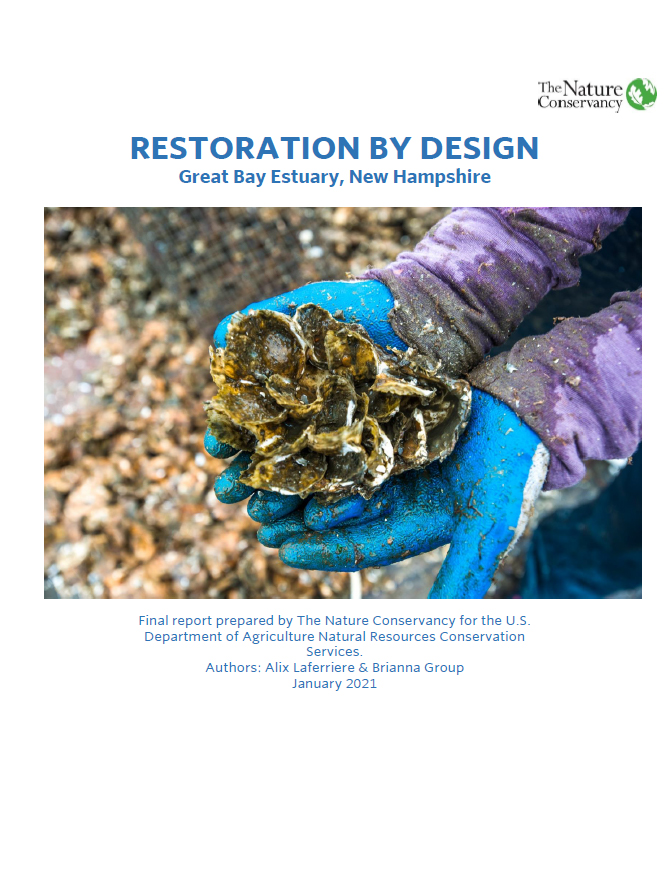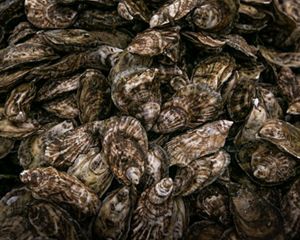
Oyster Spat Young oysters grow on recycled shell at Jackson Estuarine Laboratory in Durham, New Hampshire. © Jennifer Emerling

Why Oyster Reefs Matter
Oyster reefs are the coral reefs of the North—living breakwaters that protect shorelines and create thriving underwater neighborhoods. When oysters disappear, the whole estuary suffers. When they return, everything improves.
The eastern oyster (Crassostrea virginica) has historically played a vital role in the ecology of Great Bay Estuary. As many as one thousand acres of live oyster reef may have covered the estuary in 1970, but over 90% of oysters were lost due to pollution, harvest and disease. Without oysters, Great Bay Estuary is lacking the natural filtration capacity to maintain healthy eelgrass beds and fish nurseries as nitrogen and siltation increase.
Now with your help, the oysters are making a big comeback. Since 2009, TNC and partners have rebuilt dozens of acres of reef and restored millions of oysters, accelerating recovery each year.
Oyster Reefs are Bursting with Benefits
-

Creating Habitat
Established, healthy oyster reefs provide critical habitat for a variety of marine species. The 3D reef structure is shelter and nursery habitat for fish, crabs and more.
-

Cleaner Water and Clearer Bay
A single adult oyster can filter upwards of 50 gallons of water a day, removing algae and particles; at reef scale, that boosts water clarity and helps eelgrass recover.
-

-
Protection that Lives and Breathes
Oyster reefs enhance water quality, buffer and stabilize shorelines to prevent erosion, slow wave energy, and protect billions of dollars of infrastructure and the livelihoods of those who live and work along the shore.
-

Enhancing Fisheries
In addition to being important wildlife habitat, estuaries are critical to commercial and recreational fishing. This industry fuels the local economy.

We Can’t Save Nature Without You
Sign up to receive monthly news, updates and local events from New Hampshire.
How We Restore Oyster Reefs
Powered By Science
-
We use Restoration by Design—a process that combines historic reef maps, water quality data and community input to choose the best sites to focus our reef-building efforts.
-
From laying shell bases to planting juvenile oysters, we use proven methods to help reefs thrive. Get to know them through Restoration by Design.
-
We track survival, growth and reef health, adjusting techniques as needed.
Partnerships and People
-
Restoring oyster reefs isn’t something one organization can do alone. It takes a network of expertise, resources, and community commitment.
-
Restoring oyster reefs starts with solid science. Our science and research partners help provide the data and expertise that guide every decision—from where to build reefs to how to measure success. They help us understand water quality, habitat needs, and the best restoration techniques for Great Bay.
We're grateful to key partners like the University of New Hampshire Jackson Estuarine Laboratory, National Oceanic and Atmospheric Administration (NOAA), Natural Resources Conservation Service (NRCS), New Hampshire Fish and Game Department (NHFG), Piscataqua Region Estuaries Partnership (PREP), NH Sea Grant, and the Coastal Conservation Association of New Hampshire for all that they do!
Why they matter: Their work ensures restoration is strategic, effective and backed by science. Without science, we’d be guessing. With science, we’re building reefs that last.
-
Oyster farmers are more than food producers—they’re restoration allies. Through programs like SOAR (Supporting Oyster Aquaculture and Restoration), local growers provide surplus oysters for reef projects, while also growing some of our baby oysters for us. This partnership keeps working waters strong while accelerating reef recovery.
Why they matter: Farmers bring hands-on knowledge of oyster health and growth. By connecting aquaculture with conservation, we create a win-win for nature and local economies.
Resources you can use:
-
Community volunteers are the heart of our restoration work. Each summer, Oyster Conservationists raise juvenile oysters in cages off docks and moorings, caring for them until they’re ready for reef planting. Volunteers also help monitor reef health and collect data that informs future projects.
Why they matter: Every oyster raised by a volunteer adds to the resilience of Great Bay. This hands-on program connects people to the estuary and turns stewardship into action.
Join the Oyster Conservationist Volunteer Program. Don't have water access? You can still participate at one of our Community Oyster Gardens!
What Happens Each Season
Site Selection
Restoration sites selection based on information such as historic and current oyster beds and site conditions.

Permitting and Assessments
Complete permitting for restoration and pre-site assessments such as video monitoring and bathymetric mapping (the process of measuring and creating maps of underwater terrain).

Construction
Construct reef base with clam shell at restoration sites utilizing barge operations.

Baby Oysters
Set oyster larvae (called "spat") on oyster shell in remote setting tanks at the UNH Jackson Estuarine Lab. After about one week, move "spat-on-shell" out to a raft.

Volunteers and Farmers
TNC's Oyster Conservationist (OC) Volunteers raise oyster spat to juvenile size. UNH Jackson Lab continues to raise oysters on rafts. Local oyster farmers pick up cages of spat-on-shell to raise on their farms.

Deployment
Deposit juvenile and adult oysters from OC volunteers, UNH Jackson Lab and local oyster farmers onto a restored reef.

Monitoring and Reporting
Conduct post-restoration monitoring and write report.


SOAR: Supporting Oyster Aquaculture and Restoration
Oyster farmers and conservationists come together to support aquaculture and reef restoration in this unique partnership.
Oyster Conservation Volunteer Program
Oyster Conservationists are local volunteers helping to improve the health of Great Bay by raising young oysters in the summer and fall. We need you!

Oyster Program Downloads
-

Restoration By Design: The Full Report
PDF
Want to know exactly what goes into restoring oysters in the Great Bay Estuary and its tributaries? Here's the plan and how it works.
Download -

Restoration By Design: The Overview
PDF
Want the Cliff's Notes version? Get to know how and why we restore oysters where we do with this easily digestible overview.
Download -

Oyster Conservationist Program
PDF
Curious about the process of being an Oyster Conservationist? Take a peek at this all-in-one fact sheet detailing the volunteer "life cycle."
Download -

Oyster Restoration Timeline
PDF
How are oysters restored to the Great Bay Estuary? It literally takes a village. Here's how it all comes together.
Download -

2023 Oyster Conservationist Program Report
PDF
The American oyster is definitely the most valuable creature in the Great Bay Estuary. But due to pollution, harvest and disease we have lost over 90% of our reefs. Our volunteers are helping to turn the tide. Here's how it's going.
Download
Want more stories like this?
Sign up for our monthly e-newsletter to get the latest stories, news and updates right to your inbox!
Support Our Work
Your contributions help us continue our conservation work in New Hampshire.



